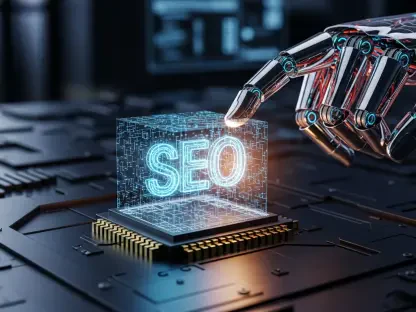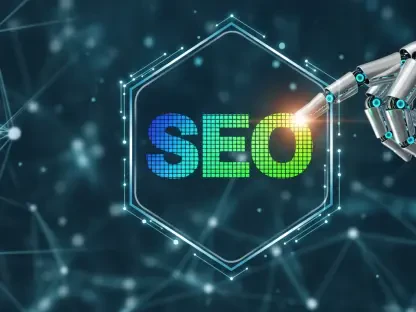Unveiling the AI Revolution in Marketing
Imagine a world where every marketing message feels like a personal conversation, crafted just for the recipient and delivered at the perfect moment. This is no longer a distant dream but a reality powered by artificial intelligence (AI), which is transforming the marketing landscape at an astonishing pace. The AI in marketing market, already valued at USD 16.59 billion in 2025, is projected to skyrocket to USD 39.21 billion by 2030, fueled by a compound annual growth rate (CAGR) of 18.94%. This staggering growth underscores the critical role AI plays in redefining customer engagement and operational efficiency. This market analysis dives deep into the trends, data, and future projections, shedding light on why AI has become indispensable for marketers aiming to stay competitive in a data-driven era.
Decoding Market Trends: The Rise of AI in Marketing
Explosive Growth and Key Drivers
The AI in marketing sector is experiencing unprecedented expansion, with its market value expected to more than double over the next five years. This surge is primarily driven by advancements in machine learning, natural language processing (NLP), and big data analytics, which enable marketers to process vast datasets in real time. Industries ranging from retail to financial services are adopting AI to enhance customer segmentation and predict buying behaviors, ensuring campaigns hit the mark with precision. Moreover, the shift toward cloud-based AI solutions has lowered entry barriers, allowing even small businesses to leverage cutting-edge tools. This democratization of technology is a significant factor propelling market growth across diverse sectors.
Personalization as a Competitive Edge
A defining trend in the market is AI’s ability to deliver hyper-personalized experiences at scale. By analyzing consumer preferences and behaviors, AI platforms create tailored content and recommendations that resonate deeply with audiences. Retail giants, for instance, use predictive algorithms to suggest products, boosting both engagement and sales. However, this trend comes with challenges, such as balancing personalization with privacy concerns, as consumers grow wary of data misuse. Marketers must navigate this delicate line to maintain trust while capitalizing on AI’s capacity to transform generic outreach into meaningful interactions.
Automation Redefining Operational Efficiency
Another pivotal trend reshaping the market is the automation of routine marketing tasks through AI. From optimizing ad spend across multiple channels to generating dynamic content, AI tools streamline processes that once consumed significant time and resources. This efficiency allows marketing teams to pivot their focus toward strategy and creativity, rather than manual execution. Despite these advantages, there’s a risk of over-dependence on automation, which could stifle innovation if not paired with human oversight. The market is thus witnessing a push for hybrid approaches that blend AI capabilities with strategic human input for optimal outcomes.
Global Dynamics: Regional Variations in AI Adoption
Regulatory and Cultural Challenges
The global adoption of AI in marketing reveals stark regional differences, influenced by regulatory landscapes and cultural nuances. In the Europe, Middle East, and Africa (EMEA) region, stringent data protection laws like GDPR create compliance hurdles, often delaying AI implementation. Conversely, the Asia-Pacific (APAC) market faces complexities due to linguistic diversity and varying consumer expectations, necessitating highly localized AI strategies. These disparities highlight that a uniform approach to AI deployment is impractical, pushing companies to adapt solutions to specific regional contexts for effective market penetration.
Opportunities for Strategic Partnerships
Amid these challenges, the market is seeing a rise in strategic alliances with technology providers to address regional gaps. Collaborations offer tailored AI solutions that align with local regulations and cultural preferences, ensuring relevance and compliance. For instance, partnerships in APAC often focus on multilingual AI models to cater to diverse populations, while EMEA collaborations prioritize privacy-first frameworks. Such co-innovation efforts are becoming a cornerstone of market expansion, enabling businesses to navigate global complexities while scaling AI applications effectively.
Future Projections: What Lies Ahead for AI in Marketing
Emerging Technologies Shaping the Horizon
Looking toward 2030, the AI in marketing market is poised for transformative shifts driven by emerging technologies like generative AI and advanced predictive analytics. Generative AI is expected to revolutionize content creation, producing highly customized marketing materials at a fraction of the traditional cost. Meanwhile, enhanced predictive models will refine customer behavior forecasting, enabling proactive campaign adjustments. These innovations promise to elevate AI from a supportive tool to a core component of marketing strategy, with accessibility improving as costs decline through cloud-based platforms.
Economic and Regulatory Influences
Economic factors, such as increased investment in AI infrastructure, are set to further accelerate market growth between 2025 and 2030. As more businesses allocate budgets to digital transformation, AI adoption will become ubiquitous across enterprise sizes. However, evolving regulatory frameworks around data privacy and ethical AI use will shape the pace of this growth. Governments worldwide are tightening policies to ensure transparency, compelling marketers to prioritize consumer trust alongside technological advancement. Balancing innovation with compliance will be a defining challenge in the coming years.
Market Democratization and Competitive Pressure
The forecast also indicates a broader democratization of AI tools, making them accessible to smaller players in the market. This trend will intensify competition, as even niche brands gain the ability to deploy sophisticated marketing strategies previously reserved for industry giants. By 2030, agility in adopting and adapting AI will become a non-negotiable trait for maintaining a competitive edge. Businesses that fail to integrate these tools risk falling behind, as the market evolves into one where data-driven decision-making is the norm rather than the exception.
Reflecting on the Market Insights
Looking back, this analysis illuminated how AI redefined marketing through personalization, automation, and global adaptation, with the market value surging from USD 16.59 billion in 2025 toward a projected USD 39.21 billion by 2030. The journey revealed both the immense potential and the intricate challenges of integrating AI across diverse regions and industries. For businesses, the next steps involve prioritizing cross-functional collaboration between marketing, data, and IT teams to maximize returns on AI investments. Upskilling employees to handle evolving tools emerged as another critical focus, ensuring adaptability in a fast-changing landscape. Additionally, forging partnerships with tech providers offers a pathway to tackle regional disparities, paving the way for sustainable growth. As the market continues to evolve, staying proactive in addressing regulatory shifts and consumer expectations stands out as a vital strategy for long-term success in this dynamic field.









